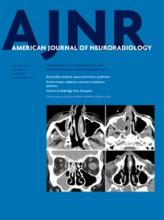Index by author
Kale, H.A.
- Head and Neck ImagingYou have accessResidual Cervical Thymus: A Normal CT Finding That May Be Present Throughout Patients' LivesA.V. Prabhu, H.A. Kale and B.F. BranstetterAmerican Journal of Neuroradiology August 2015, 36 (8) 1525-1528; DOI: https://doi.org/10.3174/ajnr.A4304
Kass-hout, O.
- Adult BrainYou have accessPerformance and Predictive Value of a User-Independent Platform for CT Perfusion Analysis: Threshold-Derived Automated Systems Outperform Examiner-Driven Approaches in Outcome Prediction of Acute Ischemic StrokeS. Dehkharghani, R. Bammer, M. Straka, L.S. Albin, O. Kass-Hout, J.W. Allen, S. Rangaraju, D. Qiu, M.J. Winningham and F. NahabAmerican Journal of Neuroradiology August 2015, 36 (8) 1419-1425; DOI: https://doi.org/10.3174/ajnr.A4363
Katzman, L.
- Head and Neck ImagingYou have accessHyperintense Optic Nerve due to Diffusion Restriction: Diffusion-Weighted Imaging in Traumatic Optic NeuropathyU.K. Bodanapally, K. Shanmuganathan, R.K. Shin, D. Dreizin, L. Katzman, R.P. Reddy and D. MascarenhasAmerican Journal of Neuroradiology August 2015, 36 (8) 1536-1541; DOI: https://doi.org/10.3174/ajnr.A4290
Kesavobhotla, K.
- Adult BrainOpen AccessEvaluating CT Perfusion Deficits in Global Cerebral Edema after Aneurysmal Subarachnoid HemorrhageH. Baradaran, V. Fodera, D. Mir, K. Kesavobhotla, J. Ivanidze, U. Ozbek, A. Gupta, J. Claassen and P.C. SanelliAmerican Journal of Neuroradiology August 2015, 36 (8) 1431-1435; DOI: https://doi.org/10.3174/ajnr.A4328
Kim, J.-h.
- Head and Neck ImagingYou have accessThe Role of Core Needle Biopsy and Its Impact on Surgical Management in Patients with Medullary Thyroid Cancer: Clinical Experience at 3 Medical InstitutionsE.J. Ha, J.H. Baek, D.G. Na, J.-h. Kim, J.K. Kim, H.S. Min, D.E. Song, K.E. Lee and Y.K. ShongAmerican Journal of Neuroradiology August 2015, 36 (8) 1512-1517; DOI: https://doi.org/10.3174/ajnr.A4317
Kim, J.K.
- Head and Neck ImagingYou have accessThe Role of Core Needle Biopsy and Its Impact on Surgical Management in Patients with Medullary Thyroid Cancer: Clinical Experience at 3 Medical InstitutionsE.J. Ha, J.H. Baek, D.G. Na, J.-h. Kim, J.K. Kim, H.S. Min, D.E. Song, K.E. Lee and Y.K. ShongAmerican Journal of Neuroradiology August 2015, 36 (8) 1512-1517; DOI: https://doi.org/10.3174/ajnr.A4317
Knoflach, M.
- Adult BrainYou have accessResidual Thromboembolic Material in Cerebral Arteries after Endovascular Stroke Therapy Can Be Identified by Dual-Energy CTA.E. Grams, M. Knoflach, R. Rehwald, J. Willeit, M. Sojer, E.R. Gizewski and B. GlodnyAmerican Journal of Neuroradiology August 2015, 36 (8) 1413-1418; DOI: https://doi.org/10.3174/ajnr.A4350
Kralik, S.F.
- FELLOWS' JOURNAL CLUBPediatric NeuroimagingYou have accessRadiation Necrosis in Pediatric Patients with Brain Tumors Treated with Proton RadiotherapyS.F. Kralik, C.Y. Ho, W. Finke, J.C. Buchsbaum, C.P. Haskins and C.-S. ShihAmerican Journal of Neuroradiology August 2015, 36 (8) 1572-1578; DOI: https://doi.org/10.3174/ajnr.A4333
The authors performed a retrospective study on 60 consecutive pediatric patients with primary brain tumors treated with proton radiation therapy. Thirty-one percent of patients developed radiation necrosis with a median time to development of 5 months. They conclude that patients with pediatric brain tumors treated with proton radiation therapy demonstrate a high incidence of radiation necrosis and a short time to development of necrosis. Multiple small areas of necrosis are frequently identified on imaging.
Krasensky, J.
- Adult BrainOpen AccessLongitudinal Mixed-Effect Model Analysis of the Association between Global and Tissue-Specific Brain Atrophy and Lesion Accumulation in Patients with Clinically Isolated SyndromeM. Varosanec, T. Uher, D. Horakova, J. Hagemeier, N. Bergsland, M. Tyblova, Z. Seidl, M. Vaneckova, J. Krasensky, M.G. Dwyer, E. Havrdova and R. ZivadinovAmerican Journal of Neuroradiology August 2015, 36 (8) 1457-1464; DOI: https://doi.org/10.3174/ajnr.A4330
Kufner, A.
- EDITOR'S CHOICEAdult BrainOpen AccessHyperintense Vessels on FLAIR: Hemodynamic Correlates and Response to ThrombolysisA. Kufner, I. Galinovic, V. Ambrosi, C.H. Nolte, M. Endres, J.B. Fiebach and M. EbingerAmerican Journal of Neuroradiology August 2015, 36 (8) 1426-1430; DOI: https://doi.org/10.3174/ajnr.A4320
The authors evaluated 62 consecutive patients with ischemic stroke with proven vessel occlusion with MRI before and within 24 hours of treatment and defined a hypoperfusion intensity ratio (volume with severe/mild hypoperfusion [time-to-maximum ≥ 8 seconds / time-to-maximum ≥ 2 seconds]). Patients with extensive hyperintense vessels on FLAIR (>4 sections) had higher NIHSS scores, larger baseline lesion volumes, higher rates of perfusion-diffusion mismatch, and more severe hypoperfusion intensity ratio.








